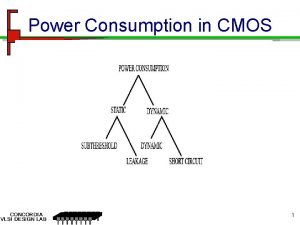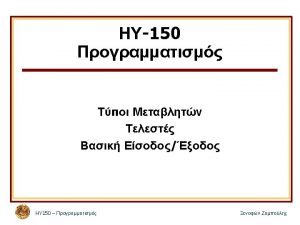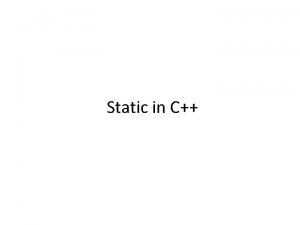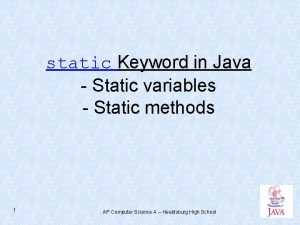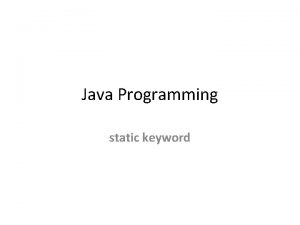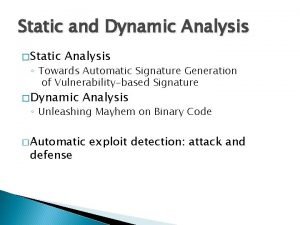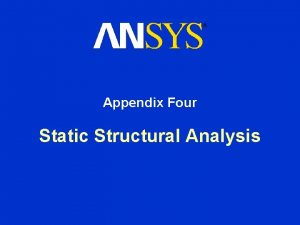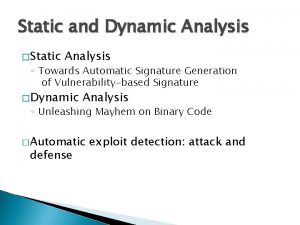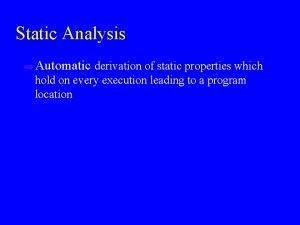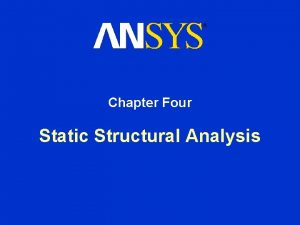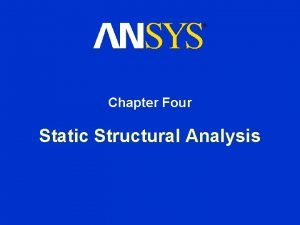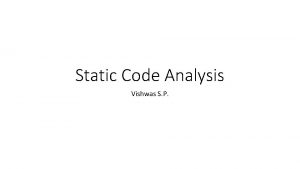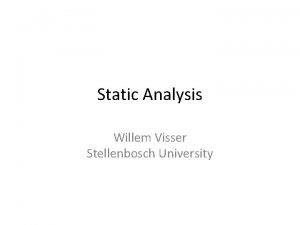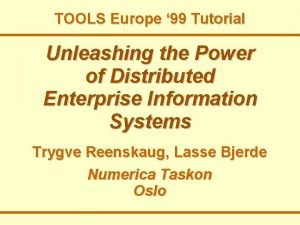Unleashing the Power of Static Analysis Manuvir Das




















![ESP example entry [Closed] T dump F Open [Opened|dump=T] T p F x = ESP example entry [Closed] T dump F Open [Opened|dump=T] T p F x =](https://slidetodoc.com/presentation_image_h/326d99d4101d251ac6e24ac63e0f2c5e/image-21.jpg)


![SAL example 1 • wcsncpy [precondition] destination buffer must have enough allocated space wchar_t SAL example 1 • wcsncpy [precondition] destination buffer must have enough allocated space wchar_t](https://slidetodoc.com/presentation_image_h/326d99d4101d251ac6e24ac63e0f2c5e/image-24.jpg)



![SALinfer example void work() { int tmp[200]; wrap(tmp, 200); } size(tmp, 200) void wrap(int SALinfer example void work() { int tmp[200]; wrap(tmp, 200); } size(tmp, 200) void wrap(int](https://slidetodoc.com/presentation_image_h/326d99d4101d251ac6e24ac63e0f2c5e/image-28.jpg)
![SALinfer example void work() { int tmp[200]; wrap(tmp, 200); } void wrap(__out_ecount(len) int *buf, SALinfer example void work() { int tmp[200]; wrap(tmp, 200); } void wrap(__out_ecount(len) int *buf,](https://slidetodoc.com/presentation_image_h/326d99d4101d251ac6e24ac63e0f2c5e/image-29.jpg)


![SAL evaluation Vista – mutable string buffer parameters • Annotation cost: [–] 100, 000 SAL evaluation Vista – mutable string buffer parameters • Annotation cost: [–] 100, 000](https://slidetodoc.com/presentation_image_h/326d99d4101d251ac6e24ac63e0f2c5e/image-32.jpg)







- Slides: 39

Unleashing the Power of Static Analysis Manuvir Das Principal Researcher Center for Software Excellence Microsoft Corporation 8/17/06 Unleasing Static Analysis, Manuvir Das, SAS ’ 06

Talking the talk … • Static analysis tools can make a huge impact on how software is engineered • The trick is to properly balance research with a focus on deployment • The Center for Software Excellence (CSE) at Microsoft is doing this (well? ) today 8/17/06 Unleasing Static Analysis, Manuvir Das, SAS ’ 06 2

… walking the walk • CSE impact on Windows Vista – Found 100, 000+ fixed bugs – Added 500, 000+ specifications – Answered thousands of emails • We are program analysis researchers – But we measure our success in adoption – And we feel the pain of the customer 8/17/06 Unleasing Static Analysis, Manuvir Das, SAS ’ 06 3

Context • The Nail (Windows) – Manual processes do not scale to real software • The Hammer (Static Analysis) – Automated methods for searching programs • The Carpenter (CSE) – A systematic, heavily automated, approach to improving the quality of software 8/17/06 Unleasing Static Analysis, Manuvir Das, SAS ’ 06 4

What is static analysis? • grep == static analysis • static analysis == grep • syntax trees, CFGs, alias analysis, dataflow analysis, dependency analysis, binary analysis, symbolic evaluation, model checking, specifications, … 8/17/06 Unleasing Static Analysis, Manuvir Das, SAS ’ 06 5

Roadmap • Engineering process • Static analysis tools • Lessons 8/17/06 Unleasing Static Analysis, Manuvir Das, SAS ’ 06 6

Engineering process 8/17/06 Unleasing Static Analysis, Manuvir Das, SAS ’ 06 7

Build Architecture Main Branch Team Branch …… Desktop 8/17/06 …… …… Team Branch Desktop Unleasing Static Analysis, Manuvir Das, SAS ’ 06 8

Quality Gates Main Branch Team Branch …… Desktop Team Branch …… …… Team Branch Desktop • Lightweight tools – run on developer desktop & feature branches – issues tracked within the program artifacts • Enforced by rejection at gate 8/17/06 Unleasing Static Analysis, Manuvir Das, SAS ’ 06 9

Central Bug Filing Main Branch Team Branch …… Desktop Team Branch …… …… Team Branch Desktop • Heavyweight tools – run on main branch – issues tracked through a central bug database • Enforced by bug cap 8/17/06 Unleasing Static Analysis, Manuvir Das, SAS ’ 06 10

Static analysis tools 8/17/06 Unleasing Static Analysis, Manuvir Das, SAS ’ 06 11

1. Code correctness • Reject code with null pointer dereferences, uninitialized memory, resource leaks, … • Inter-procedural simulation – PREfix – Process the call graph bottom-up – Perform symbolic evaluation on a fixed number of paths through every function – Build incomplete symbolic function models – Use symbolic state to avoid infeasible paths – Report defects when bad states arise 8/17/06 Unleasing Static Analysis, Manuvir Das, SAS ’ 06 12

2. Integer overflow • Reject code with potential security holes due to unchecked integer arithmetic size 1 = … size 2 = … data = My. Alloc(size 1+size 2); for (i = 0; i < size 1; i++) data[i] = … • Construct an expression tree for every interesting expression in the code • Ensure that every operation is checked 8/17/06 Unleasing Static Analysis, Manuvir Das, SAS ’ 06 13

3. Architecture layering • Reject code that breaks the component architecture of the product – No dependencies from lower layers of the system to higher layers of the system • Dependency analysis tool – Ma. X – Construct a graph of dependencies between binaries (DLLs) in the system • Obvious : call graph • Subtle : registry, RPC, … 8/17/06 Unleasing Static Analysis, Manuvir Das, SAS ’ 06 14

4. Security • Problem – A security issue is discovered through internal testing, or in the field (MSRC, Watson) • Diagnosis – Identify the code pattern that caused the bug • Detection (defect by example) – Specify the code pattern formally in OPAL – Use checkers to find instances of the pattern 8/17/06 Unleasing Static Analysis, Manuvir Das, SAS ’ 06 15

Reg. Key leak defect status = Reg. Open. Key. Ex. W( HKEY_LOCAL_MACHINE, L"SOFTWARE\Microsoft\Windows NT\Current. Version\Perflib", 0 L, KEY_READ, & h. Local. Key); if (status == ERROR_SUCCESS) b. Local. Key = TRUE; … block of code that uses h. Local. Key … if (b. Local. Key) Close. Handle(h. Local. Key); • Bug: registry key is closed by calling the generic Close. Handle API – May fail to clean up some data that is specific to registry key data structures 8/17/06 Unleasing Static Analysis, Manuvir Das, SAS ’ 06 16

Reg. Key leak code pattern • Search for code paths along which a registry key is opened, and then closed using the generic Close. Handle API • Specification: – define a sequence of relevant actions – e. g. A(k)…B(h) – define the actions (e. g. A, B, k and h) 8/17/06 Unleasing Static Analysis, Manuvir Das, SAS ’ 06 17

Reg. Key leak specification defect Reg. Key. Close. Handle { // A(x)…B(x) sequence Open. Key(key); Close. Handle(handle) message “Registry key closed using generic Close. Handle API!” // A(x) pattern Open. Key(key) /Reg. Open. Key. Ex[AW](@d+)? $/ (_, _, &key) where (return == 0) // B(x) pattern Close. Handle(handle) /Close. Handle(@d+)? $/ (handle) } This is the entire specification effort for the codebase 8/17/06 Unleasing Static Analysis, Manuvir Das, SAS ’ 06 18

Safety properties void main () { if (dump) Closed Open; fil = fopen(dump. File, ”w”); if (p) x = 0; else x = 1; Open Print/Close Error Close Opened * Open if (dump) Close; fclose(fil); } 8/17/06 Unleasing Static Analysis, Manuvir Das, SAS ’ 06 19

ESP • Symbolic state: FSA + execution state • Branch points: Does execution state uniquely determine branch direction? – Yes: process appropriate branch – No: split & update state, and process both branches • Merge points: Do states agree on FSA? – Yes: merge states – No: process states separately 8/17/06 Unleasing Static Analysis, Manuvir Das, SAS ’ 06 20
![ESP example entry Closed T dump F Open OpeneddumpT T p F x ESP example entry [Closed] T dump F Open [Opened|dump=T] T p F x =](https://slidetodoc.com/presentation_image_h/326d99d4101d251ac6e24ac63e0f2c5e/image-21.jpg)
ESP example entry [Closed] T dump F Open [Opened|dump=T] T p F x = 0 [Opened|dump=T] [Opened|dump=T, x=0] T x = 1 dump 8/17/06 [Closed|dump=F] [Opened|dump=T, p=F, x=1] F Close [Closed|dump=T] [Closed|dump=F] exit Unleasing Static Analysis, Manuvir Das, SAS ’ 06 21

5. Concurrency • Deadlocks, data races, orphan locks, … • Sequential analysis of lock sequences at every program point of every thread – Cycle in lock ordering: deadlock – Access without consistent locking: data race – Exit while holding critical section: orphan lock! • Inter-procedural dataflow analysis – ESPC – Instance of ESP – lock sequences control merge – Understands Win 32 locking semantics 8/17/06 Unleasing Static Analysis, Manuvir Das, SAS ’ 06 22

6. Buffer overruns • Defect: a buffer access index is out of bounds • Detection: check that index is within bounds • Problem: where are the buffer bounds stored? – Tools must track buffer size from allocation to access – Exhaustive global analysis is infeasible • Solution: turn global analysis into local analysis – Standard Annotation Language (SAL) – Specify buffer sizes at function interfaces – Perform modular (one function at a time) analysis 8/17/06 Unleasing Static Analysis, Manuvir Das, SAS ’ 06 23
![SAL example 1 wcsncpy precondition destination buffer must have enough allocated space wchart SAL example 1 • wcsncpy [precondition] destination buffer must have enough allocated space wchar_t](https://slidetodoc.com/presentation_image_h/326d99d4101d251ac6e24ac63e0f2c5e/image-24.jpg)
SAL example 1 • wcsncpy [precondition] destination buffer must have enough allocated space wchar_t wcsncpy ( wchar_t *dest, wchar_t *src, size_t num ); wchar_t wcsncpy ( __pre __notnull __pre __writable. To(element. Count(num)) wchar_t *dest, wchar_t *src, size_t num ); wchar_t wcsncpy ( __out_ecount(num) wchar_t *dest, wchar_t *src, size_t num); 8/17/06 Unleasing Static Analysis, Manuvir Das, SAS ’ 06 24

SAL example 2 • memcpy void * memcpy ( void * dest, void * src, size_t num ); void * memcpy ( __pre __notnull __pre __writable. To(byte. Count(num)) __post __readable. To(byte. Count(num)) void * dest, __pre __notnull __pre __deref __readonly __pre __readable. To(byte. Count(num)) void * src, size_t num ); void * memcpy ( __out_bcount_full(num) void * dest, __in_bcount(num) void * src, size_t num ); 8/17/06 Unleasing Static Analysis, Manuvir Das, SAS ’ 06 25

SAL primer • Usage example: a 0 RT func(a 1 … an T par) • Interface contracts ai : SAL annotation – pre, post, object invariants • Basic properties – null, readonly, valid, range, … • Buffer extents – writable. To(size), readable. To(size) • Buffer size formats – (byte|element)Count, end. Pointer, sentinel, … 8/17/06 Unleasing Static Analysis, Manuvir Das, SAS ’ 06 26

SAL ecosystem • • esp. X/PREfast/… : Use annotations to find defects SALstats : Identify parameters that should be annotated MIDL Compiler : Translate MIDL directives to annotations SALinfer : Infer annotations using global static analysis 8/17/06 Unleasing Static Analysis, Manuvir Das, SAS ’ 06 27
![SALinfer example void work int tmp200 wraptmp 200 sizetmp 200 void wrapint SALinfer example void work() { int tmp[200]; wrap(tmp, 200); } size(tmp, 200) void wrap(int](https://slidetodoc.com/presentation_image_h/326d99d4101d251ac6e24ac63e0f2c5e/image-28.jpg)
SALinfer example void work() { int tmp[200]; wrap(tmp, 200); } size(tmp, 200) void wrap(int *buf, int len) { int *buf 2 = buf; int len 2 = len; zero(buf 2, len 2); } size(buf, len) size(buf 2, len 2) write(buf) void zero(int *buf, int len) { int i; for(i = 0; i <= len; i++) buf[i] = 0; } size(buf, len) write(buf) 8/17/06 Unleasing Static Analysis, Manuvir Das, SAS ’ 06 write(buf 2) write(buf) 28
![SALinfer example void work int tmp200 wraptmp 200 void wrapoutecountlen int buf SALinfer example void work() { int tmp[200]; wrap(tmp, 200); } void wrap(__out_ecount(len) int *buf,](https://slidetodoc.com/presentation_image_h/326d99d4101d251ac6e24ac63e0f2c5e/image-29.jpg)
SALinfer example void work() { int tmp[200]; wrap(tmp, 200); } void wrap(__out_ecount(len) int *buf, int len) { int *buf 2 = buf; int len 2 = len; zero(buf 2, len 2); } void zero(__out_ecount(len) int *buf, int len) { int i; for(i = 0; i <= len; i++) buf[i] = 0; } 8/17/06 Unleasing Static Analysis, Manuvir Das, SAS ’ 06 29

esp. X example void zero(__out_ecount(len) int *buf, int len) { int i; for(i = 0; i <= len; i++) Constraints: buf[i] = 0; } (C 1) i >= 0 (C 2) i <= len assume(size. Of(buf) == len) (C 3) size. Of(buf) == len for(i = 0; i <= len; i++) inv (i >= 0 && i <= len) assert(i >= 0 && i < size. Of(buf)) buf[i] = 0; 8/17/06 Goal: i >= 0 && i < size. Of(buf) Subgoal 1: i >=0 by (C 1) Subgoal 2: i < len by FAIL (C 3) size. Of(buf) Warning: Cannot validate buffer access. Overflow occurs when i == len Unleasing Static Analysis, Manuvir Das, SAS ’ 06 30

SAL impact • Windows Vista – Mandate: Annotate 100, 000 mutable buffers – Developers annotated 500, 000+ parameters – Developers fixed 20, 000+ bugs • Office 12 – Developers fixed 6, 500+ bugs • Visual Studio, SQL, Exchange, … • External customers – CRT + Windows headers SAL annotated – SAL aware compiler shipped with VS 2005 8/17/06 Unleasing Static Analysis, Manuvir Das, SAS ’ 06 31
![SAL evaluation Vista mutable string buffer parameters Annotation cost 100 000 SAL evaluation Vista – mutable string buffer parameters • Annotation cost: [–] 100, 000](https://slidetodoc.com/presentation_image_h/326d99d4101d251ac6e24ac63e0f2c5e/image-32.jpg)
SAL evaluation Vista – mutable string buffer parameters • Annotation cost: [–] 100, 000 parameters required annotations [+] 4 out of 10 automatic • Defect detection value: [+] 1 buffer overrun exposed per 20 annotations • Locked in progress: [+] 9. 4 out of 10 buffer accesses validated 8/17/06 Unleasing Static Analysis, Manuvir Das, SAS ’ 06 32

Lessons 8/17/06 Unleasing Static Analysis, Manuvir Das, SAS ’ 06 33

Forcing functions for change • Gen 1: Manual Review – Too many code paths to think about • Gen 2: Massive Testing – Inefficient detection of simple errors • Gen 3: Global Program Analysis – Delayed results • Gen 4: Local Program Analysis – Lack of calling context limits accuracy • Gen 5: Specifications 8/17/06 Unleasing Static Analysis, Manuvir Das, SAS ’ 06 34

Acceptance of specifications • Developers like incremental specs – No specifications, no bugs • Developers like useful specs – More specifications, more real bugs • Developers like informative specs – Make implicit information explicit – Avoid repeating what the code says 8/17/06 Unleasing Static Analysis, Manuvir Das, SAS ’ 06 35

Defect detection myths • Soundness matters – sound == find only real bugs – The real measure is Fix Rate • Completeness matters – complete == find all the bugs – There will never be a complete analysis • Developers only fix real bugs – Developers fix bugs that are easy to fix, and – Unlikely to introduce a regression 8/17/06 Unleasing Static Analysis, Manuvir Das, SAS ’ 06 36

Theory is important • Fundamental ideas have been crucial – Hoare logic – Dataflow analysis – Abstract interpretation – Graph algorithms – Context-sensitive analysis – Alias analysis 8/17/06 Unleasing Static Analysis, Manuvir Das, SAS ’ 06 37

Summary • Static analysis tools can make a huge impact on how software is engineered • The trick is to properly balance research with a focus on deployment • The Center for Software Excellence (CSE) at Microsoft is doing this (well? ) today 8/17/06 Unleasing Static Analysis, Manuvir Das, SAS ’ 06 38

http: //www. microsoft. com/cse http: //research. microsoft. com/manuvir © 2006 Microsoft Corporation. All rights reserved. This presentation is for informational purposes only. MICROSOFT MAKES NO WARRANTIES, EXPRESS OR IMPLIED, IN THIS SUMMARY. 8/17/06 Unleasing Static Analysis, Manuvir Das, SAS ’ 06 39
 Salinfer
Salinfer Power triangle diagram
Power triangle diagram Cuckoo static analysis
Cuckoo static analysis Das alte ist vergangen das neue angefangen
Das alte ist vergangen das neue angefangen Eu fico com a pureza das
Eu fico com a pureza das Das alles ist deutschland das alles sind wir
Das alles ist deutschland das alles sind wir Ich bin die wahrheit und das licht
Ich bin die wahrheit und das licht Reflexões do poeta canto v
Reflexões do poeta canto v Dynamic and static power
Dynamic and static power Inverter loading ratio
Inverter loading ratio Hát kết hợp bộ gõ cơ thể
Hát kết hợp bộ gõ cơ thể Frameset trong html5
Frameset trong html5 Bổ thể
Bổ thể Tỉ lệ cơ thể trẻ em
Tỉ lệ cơ thể trẻ em Chó sói
Chó sói Chụp tư thế worms-breton
Chụp tư thế worms-breton Chúa sống lại
Chúa sống lại Môn thể thao bắt đầu bằng từ đua
Môn thể thao bắt đầu bằng từ đua Thế nào là hệ số cao nhất
Thế nào là hệ số cao nhất Các châu lục và đại dương trên thế giới
Các châu lục và đại dương trên thế giới Cong thức tính động năng
Cong thức tính động năng Trời xanh đây là của chúng ta thể thơ
Trời xanh đây là của chúng ta thể thơ Mật thư anh em như thể tay chân
Mật thư anh em như thể tay chân 101012 bằng
101012 bằng độ dài liên kết
độ dài liên kết Các châu lục và đại dương trên thế giới
Các châu lục và đại dương trên thế giới Thơ thất ngôn tứ tuyệt đường luật
Thơ thất ngôn tứ tuyệt đường luật Quá trình desamine hóa có thể tạo ra
Quá trình desamine hóa có thể tạo ra Một số thể thơ truyền thống
Một số thể thơ truyền thống Cái miệng nó xinh thế
Cái miệng nó xinh thế Vẽ hình chiếu vuông góc của vật thể sau
Vẽ hình chiếu vuông góc của vật thể sau Nguyên nhân của sự mỏi cơ sinh 8
Nguyên nhân của sự mỏi cơ sinh 8 đặc điểm cơ thể của người tối cổ
đặc điểm cơ thể của người tối cổ Giọng cùng tên là
Giọng cùng tên là Vẽ hình chiếu đứng bằng cạnh của vật thể
Vẽ hình chiếu đứng bằng cạnh của vật thể Phối cảnh
Phối cảnh Thẻ vin
Thẻ vin đại từ thay thế
đại từ thay thế điện thế nghỉ
điện thế nghỉ Tư thế ngồi viết
Tư thế ngồi viết








